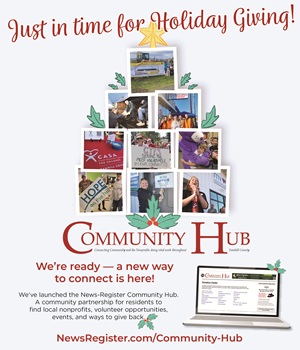Paige Matthews: Community critically as virus isolates us
To begin, I will say something not very novel: This is a hard season.
We know it, we’ve read it, we feel it. And even now, a year into a global pandemic, we still need to talk about connection. We still need to talk about the importance of community.
People are feeling isolated. They are feeling isolated from their extended families. They are feeling isolated from co-workers all toiling away separately from quiet rooms in their own homes.
Those who live alone are bearing a particularly lonely and silent burden. They feel no one else could ever understand.
Depression rates are up. Anxiety rates are up.
COVID Fatigue is burning people out, to the point where almost everyone is hurting in some way. That makes this the time we need each other the most.
Isolating during COVID-19 is tempting. It is, after all, mandated for personal safety. So how do we still engage with others in our community, and why is it important?
Connecting with others is important because it gives us those feel-good chemicals like oxytocin, dopamine and serotonin. Those chemicals help us feel alive, happy and joyful.
Can we get those feelings over video? Yes. But are we tired of getting those feelings over video? Yes.
So what do we do? How can we connect if we are living in an isolated area, unable to see our friends and exhausted from video chat?
Here’s one idea. The exercise below can help us feel connected even when we are physically alone:
If you are eating a meal, think of everyone that food connects you with. Through that meal, you are connected to the people who planted, grew, and harvested the ingredients; the people who transported the ingredients; the people who stocked the grocery store; and the cashiers who handled the sale.
In that moment, feel how many people are connected to you, how many people care about you without knowing it, and how many people worked so you could feel well. This exercise in connection feels good quickly, and is easy to practice with everyday experiences like eating.
You can also practice applying it to more challenging situations. Here’s how it worked for me:
Last week, I went to get my COVID-19 vaccine, by myself, at the Yamhill County Fairgrounds. I had an experience that I’ve been hearing is common: I pulled into the parking lot and started crying. I got inside and cried some more. I sat down for the shot and continued crying.
I cried at the combination of it all — the grief, the sadness and, ultimately, the relief.
When it came time for my 15-minute observation period, I sat in the corner alone. Sitting with just myself, I used the practice I described above to foster a sense of community.
I sat and I thought about connection. I pictured the people who researched the vaccine; the people who let it be tested on their bodies; the people who made it; the people who transported it; the people who showed me where to park; the people who checked me in; the observers who told me jokes; the EMTs who looked me in the eyes and reassured me; and the EMT who held my hand during the shot.
In that moment, I was sitting alone at a table, but I was not even close to alone. I had a team. I knew I was connected to everyone who made that moment possible for me, everyone who wanted me to stay safe, and everyone who wanted me to live.
I know this dark time does not have many redeeming qualities. But one of the silver linings is that while we often feel alone, we are actually very connected. So many people want us to be well, whether we know it or not.
Maybe you do. Maybe you are someone who feels relatively well, and you’re ready to help other people feel the same way.
If you are looking for a tangible action to take, now is the time to engage in mutual aid that directly helps your community. This means moving away from the narrative that self-care is the only answer and into the narrative that communal care is how we are going to get through this.
If you are feeling up to it, here's your chance. Find out what your community needs and begin helping to provide it.
Are people hungry right now? Yes. Are people in need of clothes right now? Yes. Are people feeling the chill right now? Yes.
How can you help them? There must be a way.
Find it. Get those feel-good chemicals going by connecting with those who need you the most.
It’s normal to feel alone during COVID because we are seeing so much less of each other. But whether you’re eating alone at home or standing out in the cold handing food out to others, remember, you are still connected to the rest of us.
If that's not enough, if you are in a crisis requiring immediate mental health support, call the the Yamhill Crisis Line at 844-842-8200 or National Suicide Prevention Lifeline at 800-273-8255.
Just need someone to talk to? Try the David Romprey Oregon Warmline at 800-698-2392.
We are an interconnected web, even at our darkest times. A huge network of people want you to feel good. A huge network of people want you to live and thrive. So you are never truly alone.













Comments